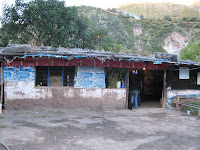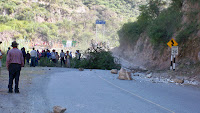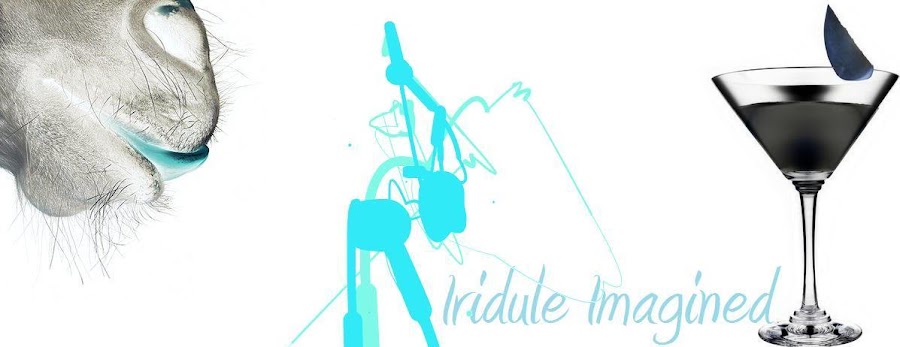 Sleeping easy in our impossibly plush, posh bus, we spent an entire night running along the Pacific coast and the Pan-American Highway to Nasca, where we began to move inland. The roads through the Andes are made up of a series of squiggling cutbacks and cliff sides, and though it was too dark to see much of the rugged terrain, we certainly felt the difference in the road’s surface between the uniformly paved Pan-American and the rustic mountain road. If it hadn’t been for the bumpy turbulence of the somewhat pockmarked asphalt and gravel, the whole thing might have felt like setting sail on the ocean. We lulled (sometimes tossed) from side to side with each cut-back, and since the roads curve with the landscape’s topography, even the relatively ‘strait’ bits had a bit of a sway to them.
Sleeping easy in our impossibly plush, posh bus, we spent an entire night running along the Pacific coast and the Pan-American Highway to Nasca, where we began to move inland. The roads through the Andes are made up of a series of squiggling cutbacks and cliff sides, and though it was too dark to see much of the rugged terrain, we certainly felt the difference in the road’s surface between the uniformly paved Pan-American and the rustic mountain road. If it hadn’t been for the bumpy turbulence of the somewhat pockmarked asphalt and gravel, the whole thing might have felt like setting sail on the ocean. We lulled (sometimes tossed) from side to side with each cut-back, and since the roads curve with the landscape’s topography, even the relatively ‘strait’ bits had a bit of a sway to them.It did take a bit of getting used to, but I think we both slept fairly well on that first night aboard the bus. Ladies and gentlemen, this is where the fairy tale ends. At approximately 9 o’clock on the morning of June 19, the bus stopped. We were not in Cusco, not even close. And what’s worse: it had no intention of starting again. Certainly, any one of the numerous run-of-the-mill problems might have occurred. We could have a flat tire, or a damaged radiator; for all I knew we could even be out of gas. But no, those things would have been fixable. We had a much more sinister, sneaky foe: Quechuans.
The Quechuan people, along with the Aymara and a smattering of other, more remote cultures, are the remnants of the Inca nation. When Francisco Pizzarro conquered Peru in 1533, he ‘rehabilitated’ the Incas – Peru’s dominant culture at the time, and architects of most of the country’s major ruins – into an approximation of his European sensibilities. Naturally the culture of Peru today is a unique fusion of the two (plus a bit of Chinese, it seems), but ultimately the conquered people had to adapt to a Westernized, Catholic lifestyle. Well, some of them didn’t adapt, and – be it for reasons of remote location, socio-economic injustice, or just plain stubbornness – those people still live in a manner stuck somewhere between the Spanish conquest and the 1930s dust bowl. The women’s hats are particularly disturbing.
 So we found ourselves stranded in the middle of a gorgeous valley – complete with craggy cliff sides, a mountain stream, flora, fauna (especially butterflies), and a small army of Quechuan farmers. They felled trees into the road, lined the ditches with thorny branches of Biblical proportions, formed a human gauntlet over a single-lane bridge, and levered boulders – yes, boulders – into the roads from the mountain face above. We’re lucky something didn’t crush our bus, because they were doing all of this while we sat there, completely dumbfounded as we watched it unfold, wondering how long it would take for the police to arrive and make them disperse. Just to clarify a point: there are no police in South America motivated enough to tell angry Quechuans they can’t stand in the road and make other people miserable (well, there are, but I’ll get to the terrors of the Bagua Riots later…); no one was coming to bail us out.
So we found ourselves stranded in the middle of a gorgeous valley – complete with craggy cliff sides, a mountain stream, flora, fauna (especially butterflies), and a small army of Quechuan farmers. They felled trees into the road, lined the ditches with thorny branches of Biblical proportions, formed a human gauntlet over a single-lane bridge, and levered boulders – yes, boulders – into the roads from the mountain face above. We’re lucky something didn’t crush our bus, because they were doing all of this while we sat there, completely dumbfounded as we watched it unfold, wondering how long it would take for the police to arrive and make them disperse. Just to clarify a point: there are no police in South America motivated enough to tell angry Quechuans they can’t stand in the road and make other people miserable (well, there are, but I’ll get to the terrors of the Bagua Riots later…); no one was coming to bail us out.Based on our bus driver’s lethargic, if somewhat annoyed response, we figured we might as well make ourselves comfortable in the valley and enjoy our afternoon. After all, it could be worse…
At around midday, there was a caravan of at least 30 cars, trucks, and buses lined up at the roadblock. We were at the front of the pack, and remained on the sidelines as a group of fast-talking Peruvian men rounded up a posse to force the protesters aside. They made there way to the gauntlet, and had a heated argument for around 10 minutes. At that point, one of the men in the bus-posse started moving rocks out of the road, and a few more started dragging branches away. As soon as they touched the trees, a loud crack rang out through the valley, and we thought someone had fired a gun. Luckily, the men on the hillside (levering boulders all the while) had only thrown a homemade firecracker. A few of the protestors on the bridge started throwing rocks, and the posse made a hasty retreat. It was at about this point that Brice and I started taking bets on which side would draw first blood.
 We spent the rest of the afternoon getting to know the other English-speaking (though surprisingly multinational) backpackers around our age, and we even re-acquainted ourselves with two of the girls who had stayed with us and enjoyed the Pisco Sours at Family House in Lima. As the hottest hours of the day approached – the valley received direct sunlight and had almost no cloud-cover from 1-3 – we occupied ourselves by searching for pretty pebbles in the stream and munching on the last of our favorite Peruvian snack food – Choko Sodas, a chocolate covered soda cracker from Nabisco.
We spent the rest of the afternoon getting to know the other English-speaking (though surprisingly multinational) backpackers around our age, and we even re-acquainted ourselves with two of the girls who had stayed with us and enjoyed the Pisco Sours at Family House in Lima. As the hottest hours of the day approached – the valley received direct sunlight and had almost no cloud-cover from 1-3 – we occupied ourselves by searching for pretty pebbles in the stream and munching on the last of our favorite Peruvian snack food – Choko Sodas, a chocolate covered soda cracker from Nabisco.Brice and I were among the lucky few of the gringos (somewhat derogatory word for white tourists) who had food provisions, and since the buses were entirely devoid of anything to eat we considered our ‘preparedness’ a small victory. As if half a loaf of bread and a chunk of swiss cheese was going to get us through to Cusco…
 Some of the people we met said there was a small cantina about 20 minutes up the road, and that we could join them for a walk up to it (passing through the gauntlet, of course) if we wanted. We didn’t have anything all that pressing to do, so we figured it couldn’t hurt. The elevation started to kick my butt about 10 minutes in, but we made it to the tin-roofed shack on top of the hill all the same. Some of the people in our group tried to order food, but the kitchen was out of everything except fish. The over-all state of sanitation in the building looked a little too infectious to tempt Brice and I, but we were able to buy a bottle of water and pet a cute kitten for a little while. Before anyone received their meal, we heard a shout from the valley and saw a few of the smaller cars from the roadblock whiz by, weaving between rocks and trees as they went.
Some of the people we met said there was a small cantina about 20 minutes up the road, and that we could join them for a walk up to it (passing through the gauntlet, of course) if we wanted. We didn’t have anything all that pressing to do, so we figured it couldn’t hurt. The elevation started to kick my butt about 10 minutes in, but we made it to the tin-roofed shack on top of the hill all the same. Some of the people in our group tried to order food, but the kitchen was out of everything except fish. The over-all state of sanitation in the building looked a little too infectious to tempt Brice and I, but we were able to buy a bottle of water and pet a cute kitten for a little while. Before anyone received their meal, we heard a shout from the valley and saw a few of the smaller cars from the roadblock whiz by, weaving between rocks and trees as they went.We double-timed it back down the hill, but our bus had started moving without us, so we had to flag it down and have them open the doors in the middle of the road. The protesters had confiscated toothpaste from the people on the bus at the time the roadblock was lifted, and they wrote “¡Viva la revolución agrícola!” in bold, minty-fresh letters on each windshield that passed by.
After what was perhaps another hour on the bus, the sun had set and we were making good time towards Cusco. Or so we thought. About 30 miles outside of the city limits, we were stopped by yet another roadblock. This time there were easily two or three hundred vehicles stuck behind the roadblock, and we knew we would have to camp out in the bus for another night. In the spirit of conserving gas, the bus was turned off and passengers were invited to either huddle under their blankets (if they were fortunate enough to have them) or brave the chilly Andean night with a campfire outside. Brice and I tried very hard to help the people in our area keep our fire going, but between the damp ditch we built it in, the damp wood we fueled it with, and the general impossibility of finding any wood at all that we could process with our meager pocket knives and multi-tools it was a losing battle against the evening chill.
Finally, someone broke out the Peruvian moonshine, and we started teaching each other – Peruvians and gringos, unite! – silly songs and ditties while bemoaning the angry Quechuans blocking the road about half a mile up the road from us. (I told you there were a lot of cars…)
The stars that night – totally unhampered by city lights of any kind – were absolutely flawless. Despite being cold and hungry, we felt that we had begun an excellent adventure with our time in the valley, and Brice and I ogled the skies – obsidian with oil slicks of Magellanic Clouds, studded with brilliant white beacons – and kept each other company.
Neither of us slept well that night. I fared much better than Brice, who maybe got one or two hours in a unnaturally contorted position, and at 6:30 in the morning one of the bilingual men on our bus announced that they were preparing to walk. Our information at the time stated that the roadblocks would start to clear at around midnight of that third night, and no one was willing to wait until 3 or 4 in the morning for the slight chance that the bus would start moving again. At first we planned to travel as a group into the next town to get food and water, but over the first few kilometers of the rubble-lined roads it became clear that the only way were going to make it to Cusco was on foot.
The group we started with thinned, and a veritable Diaspora of Peruvians trying to reach their families in Cusco started traveling down the road. Brice and I weighed our options. We got some diverse information on exactly how long it would take us to walk there, but the general consensus said that it was a half-day affair, that the roadblocks didn't stretch the entire way to the city, and that the road was uniformly flat throughout the valley. Neither of us thought we would actually have to walk the whole way to the city - we figured we'd eventually find a taxi - and Brice was vehemently opposed to spending another day at the bus, so we bought some more water and started schlepping our bags towards Cusco, through the glass and rubble-paved unknown.
 Rocks and debris littered the road, and about every hour or so we would come to a cluster of houses that may have passed for a town. The men were all occupied enforcing the roadblocks, and the women seemed to be working the fields and providing supplies to the men, leaving the children and livestock to their own devices. On a few occasions the children would boldly run up to us, and a few called out from the ditches, but one sounded genuinely surprised when he said, “Hey, it’s a gringo!” As if he didn’t expect to see us among the people walking from the buses.
Rocks and debris littered the road, and about every hour or so we would come to a cluster of houses that may have passed for a town. The men were all occupied enforcing the roadblocks, and the women seemed to be working the fields and providing supplies to the men, leaving the children and livestock to their own devices. On a few occasions the children would boldly run up to us, and a few called out from the ditches, but one sounded genuinely surprised when he said, “Hey, it’s a gringo!” As if he didn’t expect to see us among the people walking from the buses.A few hours in, we stopped to rest and a family of four Peruvians who had been trailing a bit behind us for some time stopped with us. They were kind enough to share their bag of oranges with us, and after a quick breakfast we started moving again. I had to trade bags with Brice a few times, just to spare my shoulders from the unpadded straps that had been digging into them all morning, but he was a good sport about it. We did almost jettison my toiletries, though (and I can’t say I would have blamed him if he did).
 Brice coached me through my misery (my feet were covered in blisters by hour 4), and at noon – after drinking stale seltzer water, nearly dying on a motorcycle, hearing ‘taxis in one hour more… one hour more…” for 6 hours, and then walking some more – we came to the first town of any notable size we had seen all day. I’ve looked over the maps, and I can’t narrow it down to any particular town or city. It’s too bad, because we had finally got some food there, and it was pretty good.
Brice coached me through my misery (my feet were covered in blisters by hour 4), and at noon – after drinking stale seltzer water, nearly dying on a motorcycle, hearing ‘taxis in one hour more… one hour more…” for 6 hours, and then walking some more – we came to the first town of any notable size we had seen all day. I’ve looked over the maps, and I can’t narrow it down to any particular town or city. It’s too bad, because we had finally got some food there, and it was pretty good.The nameless town we were in (Brice says he thinks it might have been called Anta) was the center of the agricultural riots in the region, and it was a bit dangerous for gringos to be in the streets at noon. This was, apparently, the biggest rally of the day. A very nice woman got us off the streets and ushered us into a restaurant, where the owner agreed to open early to let us sit out of sight (and out of the sun) while we waited for his kitchen to open.
The owner, headwaiter, and chef (aka the only guy there) came out and took our orders. He had truecha, a fish he said was only found in the mountain regions and was therefore very special to the local people, a rice dish, or an omelet. We ordered the mystical mountain fish (which we later learned, much to our embarrassment, was just trout), which came with soup, rice, a small salad, and liter of coke. We paid USD $3.50. Total. I was amazed.
And on that note, this post is TBC... It's already way too long anyway.





